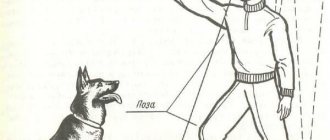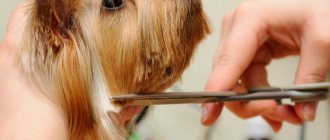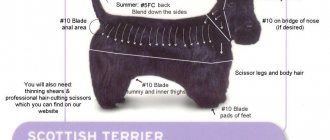It is not uncommon to encounter dogs that show aggression towards their owners when they approach a bowl of food or toys. This behavior means that the dog has a strong sense of ownership (which is in some ways a plus), and with proper training, such a pet will become a good protector of family members and home. But the threatening growl when the owner tries to take away treats or toys must be weaned off. And the best way to solve this problem is not with punishment, but with teaching the “Give” command.
On the command “Give,” the dog must give back the object he is holding in his teeth. Also, the order “Give” is used when a dog guards an object (toy, bowl, slipper) as its own property and does not allow anyone to approach it.
In OKD (general training course), “Give” is learned in conjunction with the “Fetch” command at the age of 6-8 months. But even if you don’t plan to get acquainted with fetch, you need to teach the puppy the “Give” command in any case. Training should begin at 2-3 months, when the puppy is already accustomed to his new home and playing with you.
Correct teaching of the “give” command looks like this:
- Choose something to play.
- They move it in front of the pet's face until it becomes interested and grabs it.
- They let him fray the thing.
- Then they put their hand up and wait until he drops the toy into his palm.
- When the toy is in hand, the command is “Give” or another type of command.
- The pet is then praised.
Over time, you need to increase the distance between yourself and the dog when playing. “Give” must be asked by moving away. Puppies that like to dominate will need to be trained longer than those that tend to be submissive. Correcting the behavior of natural leaders when learning a given command takes more time.
Conscientiously teaching the puppy a command is the first stage. Then you can name a thing that the dog already knows about and ask for it.
The first stage of learning the command can be shown to the puppy by a more experienced dog. You will have to learn everything else correctly on your own. Since the owners’ requirements for items may differ.
The “Fetch” command is a variation of the “Fetch” command. You can train it only in a quiet place where there are no other animals, other people's cats.
Team Features
The command “give” a toy or food is needed not only to make the dog give up all the items without exception. Without this, it is impossible to teach your pet the “fetch” command. Namely, active games during a walk make the dog’s life rich, interesting and provide it with physical activity for good health. Also, teaching your dog to give up a toy or object is important in order to prepare it for guarding or protection. It often happens that a dog gets angry and grins when strangers approach its personal belongings. This kind of aggressive behavior shows that the puppy has a developed sense of ownership, and this can be used to develop useful skills. But only with proper training and constant training. The main thing is not to punish the dog for its sense of possessiveness, but to teach it to give things into its hands.
Is your dog too active? Book an active walk!
Find out more
submit your application
“Bring it”: working on mistakes.
For dogs, this command means a fun game of searching for an object. A common mistake when learning a command is to rudely yank the thing out of the puppy's mouth. The dog will simply think that the owner is punishing him for something, and will no longer take this object.
You need to teach the command affectionately, rewarding the dog for every correct action with praise, stroking and treats.
As your pet ages, it begins to recognize the names of many things in the house. This happens to those dogs with whom the owners communicate a lot. Highly intelligent animals are able not only to understand human intonation, but also to distinguish certain words for themselves, associating them with real things. When learning the “Fetch” command, it is worth taking advantage of this property of the dog’s brain.
Teaching a dog to give away food
After your pet has learned to give away toys, begin practicing the command with a larger treat (a sinew bone, a pig's ear, or something similar).
After this stage has been completed, you can begin to take away the bowl during meals. At first, this should be done when the dog has already finished eating. Command “Give”, and yourself lift the dog’s head from the bowl, putting your hand under the throat. For the first time, instead of a bowl, offer a piece of something very tasty. Then return the bowl.
We practice the “Give” command with food
When the skill has been mastered and on the command “Give” the dog stops eating and allows him to take the bowl without objection, then there is no need to additionally reward him with a treat.
During training, try to act gradually and do not force the dog to perform a command 20 times a day. If you remember to immediately return the item or food, then learning will not take much time.
What to do if you need to pick up an item for good? Make your pet follow the command “Give” as usual, and then distract his attention with something else. It is best to praise, give the command “Sit” and reward with a treat.
Stages of training
Dog training is not an easy task and requires a lot of time and patience. In the process, you need to move gradually from simple to complex, from undebugged execution to accurate and trouble-free execution. To begin with, the dog must understand what is required of it (in this case the Dai command), and in this it needs help. Every correct action of the dog must be rewarded in order to form a positive reinforcement. This is very important at this stage of training. Wrong or erroneous actions should not be encouraged.
- The first stage is at the very beginning of training, the dog may be distracted by strangers, surrounding noise and other external factors. Therefore, classes should be conducted in a fairly quiet and secluded place.
- The second stage involves similar conditions for training, during which you need to hone the conditioned reflex to the command. To consolidate, they use restraint during execution, and also accompany the actions with an appropriate gesture. Positive reinforcement of correct actions is again used, and delays allow the dog to learn to more willingly and accurately carry out the trainer's gestures and commands.
- The third stage is necessary for further consolidation of acquired conditioned reflexes. Training is already taking place in a new environment for the dog with additional stimuli: strangers, animals, vehicles, noise, etc. To slow down the excitement from surrounding stimuli, the trainer has a different kind of influence on the pet: changes the tone of voice, repeats the command, uses mechanical impact. For final consolidation, numerous training sessions and repetition of what has been learned before are needed. All commands, including “Give”, must be executed accurately and without failure.
How to teach a dog the command “Give me your paw” if he doesn’t want to pick it up on his own?
Sometimes the puppy doesn’t want to get the treat with his paw. Trying to get to him with his teeth. In this case, try rote learning.
Say: “Give me your paw!”, take the puppy by the paw and help him reach your hand. It’s better not to pull his paw, but just push him with light tickling movements.
Give him the treat and repeat the exercise again.
Praise when the dog has just made an attempt to lift his paw off the floor. Don't wait for her to lift it all the way.
The baby will quickly understand how to get the treat and begin to lift his paw on his own.
You can lightly pat his paw at first, gradually reducing your interference. When your pet raises its paw, give the treat. And joyfully praise him: “Yes! Fine!".
Positive reinforcement in learning: Photo
Do not confuse: “Give”, “Throw” and “Fu”
To begin with, it is important to understand how this command differs from “Drop” and “Fu”. They also involve releasing an object from the teeth, but with one “BUT” - strictly on the ground, and not in the hands of the owner.
“Throw” and “Fu” differ from each other only from a formal point of view: the first can be used strictly in everyday life, and the second can be used at dog shows and other official events.
IMPORTANT!
“Fu” is included in all obedience courses and serves to indicate a total ban. You can read more about unlearning here.
At what age to start training
An animal can and should be trained throughout its life. Another question is how effective the training will be. Experts recommend not to delay, but to begin education from the first days of arrival in the house.
- From 2-3 months to 4 months there is a process of active memorization (in most breeds, some are late maturing, which prolongs the period). At this time, the puppy needs play, entertainment, and encouragement. It is better not to overload the baby, focus on repetitions 2-5 times. The dog is able to remember easy commands, its name, and some human words.
- From the age of 4 months, the pet enters an “adult” school. Both training of physical qualities and narrowly focused commands are allowed. It is better to resort to collective training, so the animal will have an incentive to perform better, in addition, such a measure will help in socialization. But retraining an adult dog will take longer.
- From 6-9 months, the pet’s character and habits are formed . But if there is a need to adjust behavior, it is better to contact dog handlers.
Useful article on the topic: “Teaching a dog the voice command: a guide to self-training.”
Clicker for dogs
By the way, in order for such behavior to become a habit of the animal as soon as possible, before delivering a speech of praise, you can use a special device - a clicker for dogs. The device, created specifically for training, received such an unusual name because of the sound it produces - a characteristic click or, simply put, a “click”. The fundamental principle of its work is to reward behavior at the moment of doing the right thing. Thus, the dog’s owner gives a timely signal using a clicker, and his faithful four-legged friend clearly understands why he receives praise. This device allows animals and people to understand each other without words.
Clicker for training
Train a dog to be mean to strangers
Sometimes it is necessary to teach a pet to be angry towards strangers, and also to teach it to bark at strangers. Such methods are used by the owners of private houses and various enterprises where strangers may enter. When a dog has close contact with its owner, sometimes there is no need to cultivate anger. But in most cases, owners turn to a dog handler for help. Only a specialist can help set up training correctly.
Before this, the dog handler must warn that such a command can be dangerous for people around him, that you need to understand the seriousness and know how to pacify the dog. You need to teach an animal to be angry towards strangers from a very early age. By the age of 4 months, the dog should already know the commands “fu”, “come to me”, “stranger”. With the help of a dog handler, you will teach her to be aggressive when you order her. By teasing the dog and catching it, the dog handler will show by his own example that a stranger is dangerous and that action must be taken immediately.
After such activities, you need to behave calmly and restrainedly, praise your pet and give various treats. An experienced trainer will teach you how to develop anger and be wary of strangers after just 5-7 lessons. The main thing is to deal with aggression correctly and quickly calm the animal after such actions.
As it was before?
Shepherd dog is focused on following the command
Let's return to the Soviet Union and the methods of teaching that emerged from it. The main method is the mechanics familiar to most current dog owners. The pet is seated opposite you, taken by the paw, pronounced the accompanying command and treated to a tasty treat. Instead of working with its brains and really learning how to act, the dog at first does not understand what they want from it. And why should she delve into it when the owner does everything on his own, also rewarding the pet with treats...?
Modern training involves new methods of teaching dogs. Even such a simple command as “give me your paw” becomes interesting for the animal if the correct approach to teaching it is used.
Why does the puppy give his paw without a command?
You started practicing the command, and the puppy quickly understands: you need to raise your paw and get food. Therefore, the dog often gives its paw without a command. Especially if you are happy about it and encourage her. This is how the dog tries to earn a treat. Sometimes he insistently demands it from you. Don't pay any attention to it. Reward your dog only when he raises his paw at your command. Do not forbid the puppy to raise its paw without a command. Just “don't notice” it. A clear algorithm must always be followed: TEAM - ACTION - INCENTIVE. Gradually, the pet will understand and get used to the fact that the treat will only be given after the command “Give me your paw!”
Possible problems during training
The pet refuses to take the item. When faced with such a situation, do not try to force an object into its mouth - this will cause a negative reaction. Instead, gently place the item between your dog's teeth and lightly squeeze the jaw with your fingers for 1-2 seconds to prevent him from spitting it out. After that, quickly take the item and reward it. Repeat the exercise several times, gradually increasing the time for which the dog must hold the stick.
The dog refuses to give up the item. It also happens that a pet loves to play with a stick, but refuses to give it up . In this case, the recommendations below will help you:
- Wait until the dog is busy playing with a stick (or toy). Take a stick, walk up to your pet and wave it. When the dog grabs the stick, strictly say “Give,” take the thing, and then immediately return it back;
- If the pet still does not give up the object, then you need to gently stroke or shake it, but strictly repeat the same order. As soon as you feel a weakening of the grip, carefully pull out the stick, praise the animal and immediately return the thing;
- In the early stages of training, you can use a treat to get the dog to let go of the object, but the main positive reinforcement is its return and praise.
You need to practice the dog’s habit of giving away an object about 3 times a day at long intervals. Later, you should begin to take away the stick at those moments when the pet plays alone, gradually increasing the time between the command and returning the stick.
As you train, you will realize that teaching a dog to carry a stick is not that difficult. Remember that patience is the key to the dog successfully mastering this skill, so do not rush things, but carefully practice each stage.
Choosing a suitable toy for practicing the Fetch command
When purchasing a toy, consider your dog's age, size, and abilities. If your dog is older or younger, choose a toy that is easier to grasp with his teeth. If your dog is adept at returning toys to you, choose a toy that presents a more challenging task.
Here are some popular toys:
- Standard tennis ball
- Soccer balls or tennis balls
- Discs and flyers made of soft, flexible rubber—especially those that are extra gentle on sensitive mouths or designed to remain flexible in cold weather.
- Rope toys with rubber tips
- Plush Animal Shaped Dog Toys
Trick for the enthusiast
If you want your dog to be able to crawl, roll over, “serve,” walk on its hind or front legs, and perform other circus tricks, you should make the training more difficult. It is worth starting such training only when your pet has mastered all the basic commands.
To teach your dog to roll or turn, dangle a treat in front of his nose, and then turn your hand so that it is comfortable for the animal to spin along the same trajectory. Interesting, unusual teams will require a lot of endurance from you. The result will delight both you and your guests, and your adult pet will learn how to perform mini-circus performances at home.
Typical trainer mistakes
To teach your dog commands (including “Give”), you should avoid the following common mistakes.
- Indifference to training sessions, work without reward with a walk or play, strict adherence to a template training program.
- Inattentiveness of the trainer at moments when the dog exhibits innate tendencies. Incorrect or untimely reward, when, for example, a dog barks at a passing person or animal or tries to grab a bird.
- Poor command technique by the trainer: violation of the rules of uniformity, unclear voice commands, inconsistent gestures and signals. In such cases, the dog’s process of developing a conditioned reflex is disrupted, and it may also become frightened.
- Unclear command delivery, replacement of the command with another consonant word: “sit down!”, “sit down!” instead of “sit!”
- Careless handling of the animal during training: accidental blows with a carabiner or leash, stepping on paws, improper use of training equipment.
- Poor knowledge of the dog’s character and, accordingly, the reasons why the animal refuses to obey commands (including the Dai command). Lack of awareness regarding physiology and behavior.
- Assessing a dog’s behavior as if it were a person (humanizing the dog) is the most common and serious mistake made by a novice trainer, trainer or ordinary dog lover.
- Incorrect development of an acquired reflex in a dog, inability to use conditioned and unconditioned stimuli, untimely reinforcement.
Team from different positions
Give me your paw, friend!
We are talking about the owner’s position, because any dog, even the longest-legged one, cannot give a paw while lying down.
The fact is that over time, the pet develops a conditioned reflex: to give the owner a paw only when he is sitting opposite him. After all, most owners squat down or kneel down (depending on the size of the dog), practicing the “give paw” command at home.
It's time to try something new: stand or lie down in front of your pet and give the necessary command. You can move a little to the side instead of being in front of the animal.
By the way, such science can be useful if the owner wants to try himself and his pet in canine freestyle, for example.
How to teach a dog to bring objects to its owner?
A new family member has appeared in your home - a small puppy.
Accustoming a puppy to fetch should begin at the age of 3-4 months. The dog will only bring you items when it likes it. And only habit can force you to bring a stick to the owner even if the animal does not want it. Almost all dogs can be trained to fetch objects on command. Such an object can be a toy, a stick, a leash, etc. There are animals for whom mastering this skill will not be difficult. For others, mastering “fetching” may be more difficult. Then you will need more patience and time. The smaller the puppy, the faster he will learn a new command. A very favorable age for training puppies is 3 or 4 months.
It is best to start learning “fetching” with light objects. Choose a suitable ball or rubber toy from the online pet supply store. The main thing is that the dog can easily pick it up from the ground and hold this object in its teeth. The item should be removed immediately after training. Before training a dog, you need to let it look and smell a new thing that the owner has chosen for training with the dog. If the dog grabs an object with its teeth and holds it, then you need to praise the pet. But if the “pupil” begins to gnaw on an object, chew it and play with it, then there is no need to praise.
When the dog takes an object with its teeth, the command “Take” sounds, and when it puts the object on the floor, the command “Give” sounds. You can teach your dog to bring you bowls, slippers, a bucket, a leash, etc.
What do you need to remember and take into account?
In the process of teaching a dog the “give” command, you need to take into account some nuances:
- You should not train if the dog is not in the mood;
- You cannot scold, beat or show aggression towards your pet if it fails to correctly execute the command;
- Always give the toy back after following a command or offer something in return;
- You should not pull the object too hard, as this will cause a backlash;
- Working out takes no more than 10 minutes three times a day;
- You cannot complicate a task or move to a new stage until previous skills are consolidated.
Every pet needs to be taught the “give” command, even if we are not talking about guard or hunting breeds. After all, it disciplines, lays the foundation for other teams, develops mental abilities and logic, and promotes harmonious interaction between dog and person. What is important is that it is not at all necessary to contact a professional dog handler. This simple command is learned by the dog within a few weeks, especially in the case of puppies. It only requires a little attention and patience from the owner.
Conclusions and recommendations.
- You should start training after familiarizing yourself with the skills of “Sit” and “Lie down”.
- Early training is not recommended. For informational purposes only.
- Don't forget the gesture.
- Give the command loudly and clearly, without unnecessary words, like “Stop already.”
- It is advisable to find an assistant; the process will go faster and better.
- Don't try to force things. Introduce complications gradually.
- Start studying in a quiet place, without the presence of strangers.
- Never call your pet after performing a skill.
- Watch your paws, they must be in a strictly defined position.
- Conduct your first training sessions in dry weather. In winter, it is advisable that there is no wind or snowfall.
- If your ambitions in terms of training do not go far, do not torture yourself or your partner. Achieve everyday fulfillment of your requirements.
Good luck and understanding to you.
Common mistakes made by amateur trainers:
- very frequent and sometimes unreasonable use of the prohibitive command “fu!”, which leads to intimidation of the animal or the development of complete indifference to a very important command;
- constant change of nickname, use of an affectionate or diminutive form;
- indecisive behavior of the trainer, uncertain and monotonous commands (including the “Give” command), lack of persistence and demands towards the dog, pleading intonation of the voice;
- smoothing effect - rewarding the dog after the prohibiting command “fu!”, at the same moment or immediately after it.
How to teach a dog or puppy the “Give” command











